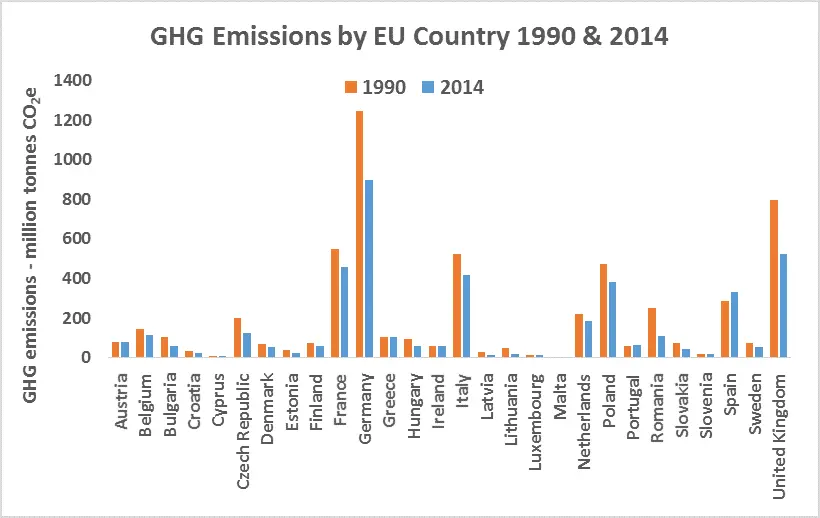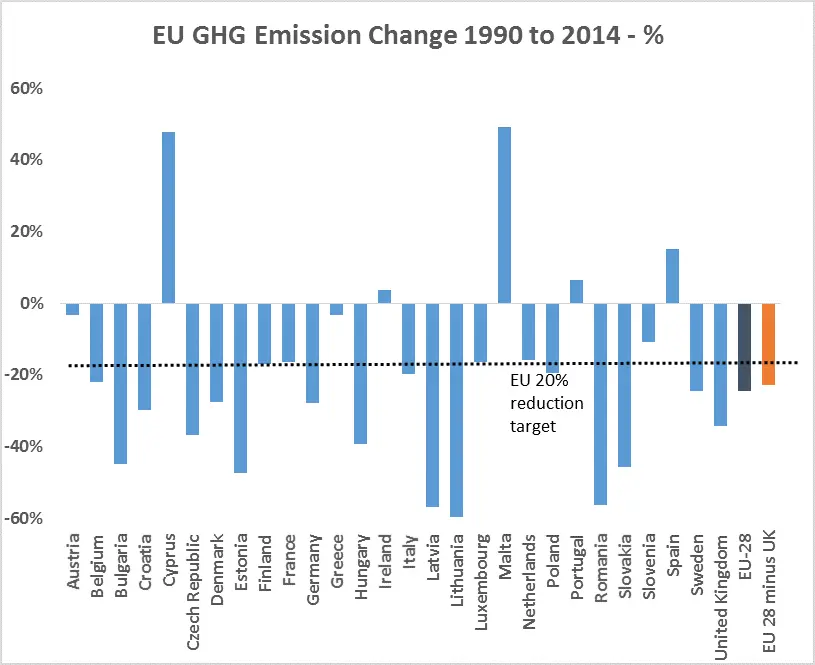Blog, Carbon Footprint, Energy
EU Greenhouse Gas (GHG) Emission Targets: The Brexit Effect
The referendum on the UK’s membership of the EU sent shock waves around the world. The decision to leave the EU has strong implications, but these implications are yet to be understood. It could impact the economy, society and of course, the environment. In regards to the environment, we can at least ask – what are the implications for the EU’s greenhouse gas (GHG) emission reduction targets? Does it hinder or help the EU’s route to sustainability?
To provide some background, the European Union, which composed of 28 members at the time of writing, has committed itself to reducing greenhouse gas emissions 20%, below 1990 levels, by 2020. There is an additional target for 2030, which is a more stringent 40% reduction. The uncertainty around the UK’s future role in the EU has led us to ask, what is the Brexit effect upon these targets?
EU GHG Emissions by Country
Let us start by looking at the current EU greenhouse gas emissions per country and the amount of emission reduction already achieved. The GHG emissions for all 28 EU countries are shown in the figure below. It shows both the 1990 baseline year and the latest year of data, 2014.
The chart shows that the UK is the second largest emitter of greenhouse gas emissions in the EU 28. In 1990, the UK emitted 797 million tonnes of CO2e. This was only behind Germany, at a very significant 1,246 million tonnes of CO2e. At first glance the removal of the second largest emitter of greenhouse gases in the EU might not be missed. However, it might not be that simple. The largest emission sources are also, by definition, the main carbon hotspots. Therefore they often pose the largest potential for emission reduction measures.
In regards to reduced emissions, in 2014 the UK emitted 524 million tonnes of CO2e, which is a significant reduction of 34.3%. This is well ahead of the EU’s 20% reduction target by 2020. Maybe the UK’s reduction will be missed after all. Let’s investigate further…
EU GHG Emission Reduction by Country
Let’s take a closer look at the GHG emission reduction by EU country. The chart below shows the absolute amount of emission reduction, in million tonnes of CO2e.
The chart shows that the UK made the second largest reduction of GHG emissions, in absolute terms, which was only behind Germany. The UK reduced emissions by 273 million tonnes CO2e between 1990 and 2014. This is only behind the 346 million tonnes CO2e reduction that Germany achieved.
It’s interesting to note the large gap to the third largest emission reduction in the EU, which was Romania. Romania reduced their greenhouse gas emissions by 142 million tonnes CO2e. A significant number and represents an impressive 56% reduction over the 1990 baseline for Romania.
This still leaves the question of how does Brexit effect the EU’s GHG emission reduction targets. Will the removal of the UK from the EU targets be beneficial for the carbon reduction efforts, or will it leave a reduction shortfall? Perhaps the other 27 EU countries will suddenly have more work to do.
Brexit Effect: The EU Greenhouse Gas Reduction Targets
To answer this pertinent question, we have compiled the reduction of GHG emissions by EU country, along with the total emission reduction for the EU 28 and also the hypothetical (at the time of writing) new EU 27 (note: we have called it the “EU 28 minus UK” on the chart. This is to avoid confusion with the previous EU 27, which was the number of EU members before Croatia joined, to make it the EU 28).
The chart shows that the EU 28 have achieved a 24.4% reduction in GHG emissions. This is already beyond the target for 2020, which was a 20% reduction. The removal of the UK from these results (EU 28 minus UK) achieves a 22.8% reduction in GHG emissions. This is a 1.6% difference, being a smaller reduction without the UK in the figures.
Summary
To summarise, the UK has been an important reducer of greenhouse gas emissions which have contributed well to the EU reduction targets. However, it is also one of the largest emitters of GHG’s and many other EU countries have also made significant CO2e reductions.
The effect of Brexit upon the EU emission reduction targets is a 1.6% reduction in the emission improvements. This is a notable amount. However, with the EU 28 minus the UK already on a 22.8% CO2e reduction, it is unlikely to make any notable difference to the EU’s ability to achieve the 2020, and possibly the 2030, emission reduction targets.
What do you think?
Data Source Reference: EEA, 2016. Annual European Union greenhouse gas inventory 1990–2014 and inventory report 2016 – Submission to the UNFCCC Secretariat, European Environment Agency (EEA), 17 June 2016.
If you like this post please consider sharing it on social media using the share buttons or signing up to our Newsletter.




